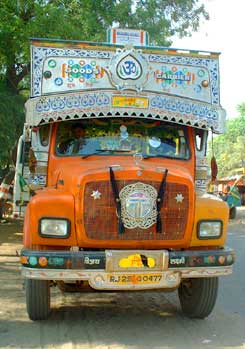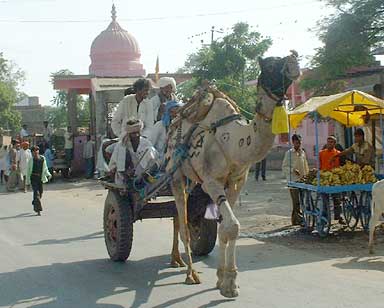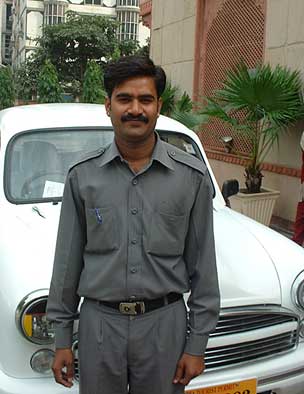Rules of the Road
 |
|
The trucks on the highway are highly decorated. |
It seems important to make a few notes about road life here, before I become too acclimated and no longer notice.
On the highway, the roads are somewhat narrow, and must accommodate all types of transport — that means cars, trucks (see the photo we include), many bicycles, motorcycles (many here seem to carry entire families, easily mom and dad and 2 kids, mom with her sari blowing in the breeze), carts pulled by you-name-it (camels being most common here in Rajasthan, also oxen, donkeys, horses, bullocks). Add to the mix many pedestrians, mangy dogs, monkeys, and all types of cows, even those taking a nap. The idea is to drive with your horn — even the back of the trucks state the instructions: "Blow horn — Use dipper at night." That means, in the day, let the trucks and others you are about to pass know of your plans by honking, and at night, flash your lights. Driving is a very active and engaging activity, which must require the driver's full attention it seems (I hope). Because with this mixture on the road, you can imagine that no one is going the same speed - making it necessary to pass. Staying in one's lane, you would never reach your destination. On these highways, we have been in a hired car with a driver, who knows the roads and seems to understand the many unspoken rules, which we are struggling to grasp (see section on Guides, Drivers and Others). Our driver must manage the many obstacles that await him — that may mean an overturned truck — it seems that the trucks here tend to overload, get top heavy, and tip over — or it may be herd of camels en route to the nearby fair, a herd of goats led by a small boy, or road construction. As with so much of work here, people seem to do more of the work that machines do at home; we see women in their saris piling rocks into a basin, which they carry on their heads from place to place on the road construction site.
 |
|
You have to dodge any number of a variety of vehicles. |
In the city, it seems to my naive eye that the rules are a bit more squishy. Of course, as always you drive on the left a la English style. But beyond that, I think you may be on your own! Indeed, at times it seems even the side of the road is optional. As on the highway, there are all manner of vehicles — add to the above list the bicycle rickshaws and motor rickshaws (a bit like a 3-wheel motorcycle with a compartment to sit in). Horns, pollution, people on the sides of the streets, cows crossing the roads, dogs seemingly everywhere — it all seems a bit chaotic!
Guides, Drivers and Others
 |
|
Rajanindra, the best driver in all of Rahasthan. |
We have also hired guides to show us around. Our guide in Jaipur was Ashoke; after the tour was over, he invited us to his home that evening to have a drink and meet his wife and daughter. Even though his wife spoke no English, we felt so welcomed in their home. In Agra, our guide for the Taj Mahal and three other sites was Mr. Franklin, one of the most enthusiastic story-tellers you are likely to encounter. His tales made the history of these amazing monuments come alive! But he did not stop with the history - I think he was an amateur sociologist in disguise, and took great joy in explaining some of the happenings around us. For example, he pointed out a very interesting family outing - he explained that this apparent family outing was actually an introduction of a boy and a girl, being considered for an arranged marriage. The girl looked all shy and innocent in her pink glittery sari, and the boy looked pretty awkward in his pressed yellow shirt - we are wondering if a marriage was arranged.
There are also all sorts of additional potential helpers. Some amaze, like the porter (actually called a "coolie" here) who carried our two heavy suitcases on his head, plus another bag, all through the train station. It is a whole new set of skills to figure out how much to pay for such a service! Some we are less eager to hire, like the many hawkers pushing their wares - often literally pushing them in your face - or those so eager to have you ride in their rickshaw when you want to walk!
We are wondering about the source of the service culture here. Does it go back to the English, who required of the Indians the proper service to make their lives here comfortable? Or does it go further back to the maharajas and moguls, who lived so well with the support of their many servants? Or is it all because in relative terms, we are so embarrassingly wealthy that we are served in this manner? In any case, it is a different view of the world.
 |
|
Mr. Franklin launches into another dramatization of Moghul history. |